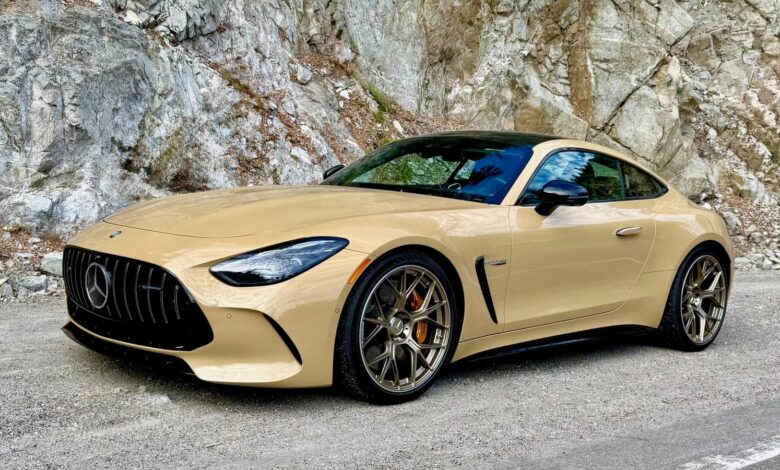Test Driving The Mercedes-AMG GT 63 S E PERFORMANCE: 805 Horsepower

📝 usncan Note: Test Driving The Mercedes-AMG GT 63 S E PERFORMANCE: 805 Horsepower
Disclaimer: This content has been prepared based on currently trending topics to increase your awareness.
Mercedes-AMG GT 63 S E PERFORMANCE is a gas-electric hybrid Super GT that has one of the best and most complex elevator stories of 2025 and ‘26. At the top of the list is the combined gasoline-electric power of 805 horsepower. Most important is the combined torque figure of…1047 lb.-ft. in Sport+ and RACE modes.
Mark Ewing
AMG’s GT 63 S E PERFORMANCE has a touch over 800 horsepower and no less than 1047 lb.-ft. of torque, yet this superbly sorted hybrid Gran Turismo doesn’t fall into the category of too much is just barely enough. GT 63 S E never forgets that it’s also a Mercedes.
AMG has mounted an electric motor at the rear with its own 2-speed gearbox. Motor, gearbox and battery are an integrated unit. The motor generates a maximum of 201 electric-equivalent horsepower, and 236 lb.-ft. of torque. As speeds climb, the motor’s gearbox will kick it up a notch, to ensure that electric torque remains a factor at higher speeds and not just at launch. The lithium-ion energy storage system is 400-Volt and liquid-cooled. Battery chemistry is formulated for performance, for extremely rapid discharge and recharge.
Mercedes-AMG
GT 63 S E delivers an emotional, visceral experience while remaining coolly cerebral, even with so much power on tap. Dial up Comfort mode, and one can toddle over to the golf club or the school drop-off line with the Tiger Moms and never realize 63 S E’s outrageous potential, such is its measure of civility.
My test car on a favorite mountain road. Note the long wheelbase, which aids high-speed stability as well as comfort, and also gives the aerodynamicists a nice run for the aerodynamic belly pan. Hood may appear incredibly long, but from the driver’s seat the car reads as tidy and almost stubby.
Mark Ewing
Dial up Sport+ or RACE mode, put the hammer down and GT 63 S E feeds power and torque into its all-wheel drive system. Electric torque is transferred to the front wheels if the enormous rear tires lose the slightest traction. AMG’s all-wheel drive is ruthlessly efficient.
With seat all the way back while maintaining comfortable seatback rake, my arms were at near full extension, just short of elbow lock, and my shirt’s sleeve is a 36.
Mark Ewing
GT 63 S E launches like all such cars of our era with computer-controlled traction and stability control. Press your head firmly back, draw a breath to resist the sense of compression on the chest, tighten the abdominal wall, then floor the throttle and sidestep the brake—let it rip.
Dial up Sport+ or RACE mode and all the horsepower and torque is available.
Mark Ewing
To use the phrase, 63 S E accelerates at an accelerating pace, or at least that’s how it feels because there is no relenting, no mercy. In Sport+ or RACE mode, you unleash Hell.
AMG GT has the desired feel of a cockpit in a tiny personal jet aircraft. Dashtop rarely reflects into the windshield, a benefit from both the somewhat upright windscreen and the curvature of the dashtop. Knees can be comfortably braced against the central tunnel and the door panel when cornering with aggression.
Tenzion Photography / Mercedes-AMG
GT 63 S E will rocket to 60 mph in 2.7 seconds. I counted it off in my head while performing the deed on carefully chosen cliffhanging 2-lanes and have no doubt about the figure. Better still, it puts down power with style exiting corners, the car delivering information about just what the powertrain is doing. GT 63 S E has that sensibility of being alive.
Twin-turbo V8 a product of the AMG one-man/one-engine assembly line. Engine in my test car signed by the builder. Nicely done, Dennis. Engine develops 603 horsepower between 5500-6500 rpm, and 627 lb.-ft. of torque over a broad range, from 2500 to 5000 rpm.
Mark Ewing
Because 63 S E has a V8 with the turbos placed up top in the Vee, the package dimensions are essentially a cube. Which means that even if the hood seems long in photos, it really isn’t. The motor/gearbox/battery is a single package placed on the rear axle and does not adversely impact cargo space, ample enough for a long weekend away. This motor/gearbox/battery is essentially the same one used in the Mercedes-AMG C 63 S E I drove about a year ago.
Twin-turbo V8 displaces 4 liters and produces 603 horsepower between 5500-6500 rpm. Better still, it spools up 627 lb.-ft. of torque in a broad range, from 2500-5000 rpm. And that is of course supplemented by the motor/gearbox/battery unit placed along the rear axle. It’s basically the same unit used in the AMG C 63 S E which I drove this time last year. Thanks to the gearbox, the electric torque is available at high speeds as well. And in Sport+ and RACE modes, the full 236 electric lb.-ft. is available bringing the powertrain’s total to 1047 lb.-ft. And one last point is the all-wheel drive system. If the rear wheels are close to being overwhelmed with torque, more gas and electric torque can be apportioned to the front wheels.
Mercedes-Benz AG
Unlike V12 front-engine cars that require the driver mentally adapt to the length of the hood, on the hunt in GT 63 S E the driver knows instinctively where the front wheels are, where the corners of the car are. In just a few miles the car feels wieldy, breeding confidence. Even those with limited sports car and GT experience can acclimate quickly, understanding the car’s dimensions on an unforced subconscious level. Like any of the best GTs, the car melds with the driver.
Switch from Comfort to Sport or Sport+ while driving and the change in the weight and action of the steering is immediate. The steering feels meatier, weightier, more responsive. Most corners are accomplished with little more than a flick. Gauge pod has a flat screen with shrouds to deflect any sun glare.
Mercedes-Benz AG
Cabin architecture is a smart 21st Century interpretation of the tidy cockpits of Golden Era Gran Turismos from the 1950s and ‘60s. Thanks to the relatively steep windshield, tall side glass and reasonable view to the rear three-quarters, the cabin has the sensibilities of a tiny private jet aircraft. I’m 6 foot 2+. Climbing in, I had to dip my head to clear the top of the doorframe, but once in, headroom under the panorama glass roof is ample by GT standards.
Bronze 6-piston calipers with carbon discs measuring 16.5 inches tall. Note how the fender and hood are just barely taller than the top of the wheel arch. Big brakes, but advanced materials keep weight down, which helps both steering, and suspension performance. Tires are 295/30 on 21-inch AMG forged wheels.
Mark Ewing
With seat adjusted all the way back while maintaining comfortable seatback rake, my arms were at near full extension, just short of elbow lock, and my Hamilton tux shirt’s sleeve is a 36. Just enough room for that quarterback who has signed his contract extension. Unlike in many mid-engine cars that have tight footwells due to the wheelarches crowding in, GT 63 S E accommodated my size 13s, with ample room to relax ankles while driving on open highway.
Front splitter leads to an undertray that shapes and guides airflow under the car. At speeds above 50 mph, a carbon-fiber panel located under the nose lowers automatically by 1.6 inches. The resulting venturi effect in essence sucks the car down, ensuring the front wheels are firmly planted at ultra-high speeds. Front-end lift is necessary. There is no analog button to lift and lower, but the steps are just as simple. Touch the button on the center console with the car symbol, a menu appears on the center screen, tap the front-end lift image, and unexpected steep driveways are easily navigated. An owner can program known steep inclines in parking structures and daily drives with GPS.
Mark Ewing
Under deceleration, the singing of the electric motor recuperating energy is heard by sensitive ears. It’s nothing like the sharp machine-tool sounds of a Le Mans hybrid race car. The electric motor’s song is subtle. On the go, honestly, you don’t notice or pay attention. Call it a subtle reminder that there is an electric motor, 2-speed gearbox and battery pack on the rear axle line. Predominant sounds are the rich burbly exhaust that turns sharp with deep throttle application, and the upper intake symphony of that glorious hand-assembled V8.
Here the right rear plug-in cover panel is clearly seen. But the wise owner will rarely ever need it. Why? In RACE mode the battery recharges aggressively. I saw a 25 percent gain in a matter of perhaps 10-15 minutes toddling around treelined, quiet suburban streets. Even if the battery is depleted on a Dawn Patrol run, one must only switch to RACE, chill out, and the battery will recuperate.
Mercedes-Benz AG
Switch from Comfort calibration to Sport or Sport+ while driving and the change in the weight and action of the steering is immediate, as if the steering system’s “flexors and extensors” are juiced up like when you’re placing a secure grasp on a barbell. The steering feels meatier, weightier, more responsive. Most corners are accomplished with little more than a flick.
Rear brake discs measure 15 inches tall. Wheels and tires are “staggered,” meaning rear tires are significantly larger than fronts. My test car was shod with Michelin Pilot Sport measuring no less than 305/30ZR 21. Test car wore optional forged AMG wheels. Rear axle steering is standard.
Mark Ewing
Every great car earns a nickname, and this one became known as Jochen, in honor of the late, great Jochen Maas, the bon vivant merry prankster who piloted a Sauber-Mercedes Silver Arrow to victory at Le Mans in 1989. Jochen’s fine drive at the Sarthe stands resolutely as an early mile marker for Mercedes’ renewed embrace of high-performance and racing. From Jochen’s glorious victory came a string of Formula One world championships, Indy 500 victories, and the absorption of the AMG tuning house into Mercedes-Benz to become the powerhouse it is today. So yeah, Jochen is a fine nickname for any AMG 4-wheeled missile.
In Sport+ I lined up the car on a straight uphill section defined by cliff face and guardrail and put the hammer down. No doubt, GT 63 S E will hit 60 in well under 3 seconds, and does so without histrionics, just the bellow of the V8 and the sensation of electric torque being shot forward to the front wheels. Thanks to computer controls, there’s nary a single horsepower or foot-pound lost to inefficient spinning. All the power just goes straight to the pavement, those big Michelins digging in their claws.
Mark Ewing




